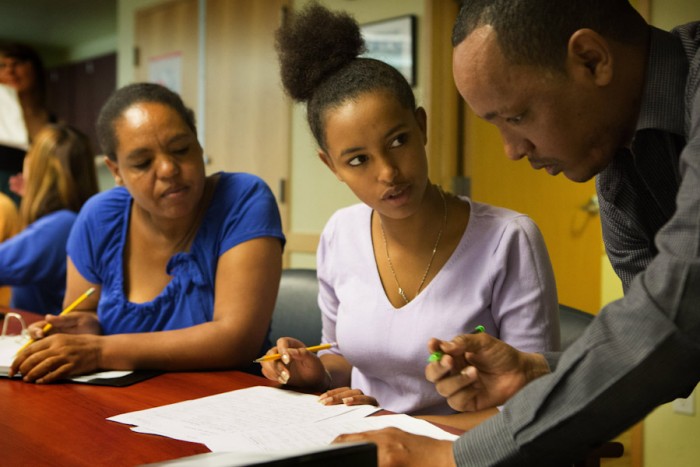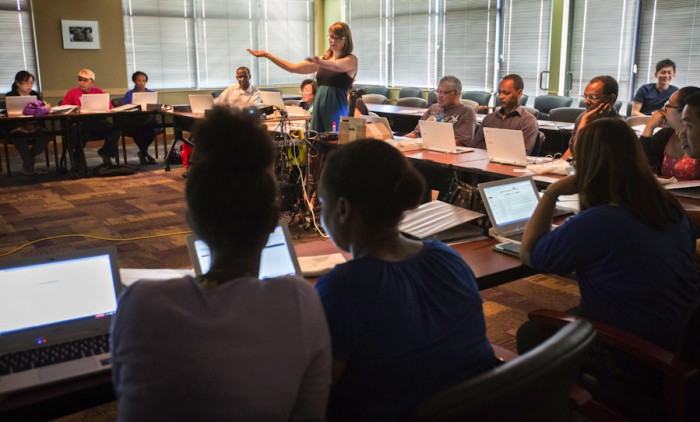
Ever been frustrated trying to find a job? Navigating an online application process or prepping for an interview in a brand-new field can be intimidating.
Just off Rainier Avenue, in a classroom lit by a glowing screen projecting the basics of emailing, 15 people from around the world are learning how to do just that — but in a new culture and in a foreign language.
“First they need to learn the English language … then they are able to apply for a job, do their own résumé, able to communicate to the work force,” says Abel Ghirmai, project director for the city’s first Ready to Work program for ELL (English Language Learners). “We’re also teaching them basic computer instruction, so by the end of the course at least they’re able to communicate on their own terms using email.”
Ghirmai, who works for HomeSight, the organization administering the Ready to Work project for Seattle’s Office of Immigrant and Refugee Affairs, knows that path well. Not only was he once a new immigrant to the U.S., but he says learning English was the key to his career.
“When I see these people, they are in the place I was in a few years ago,” says Ghirmai, who took English classes at Highline Community College and eventually went on to become an instructor at the same school. “I want them to [have] the same opportunity I have now.”
Seattle has changed since Ghirmai’s arrival from Ethiopia 24 years ago. Our city’s international community has grown and our region is experiencing low levels of unemployment. But he worries that new immigrants and refugees might miss out on the boom if they don’t get help with language and technology skills, as well as job placement.
“People can get a job, but they have no advancement opportunities,” says Alexandra Olins of Asian Counseling and Referral Service, which hosts Ready to Work classes through the rest of the summer.

Olins says typical jobs for new immigrants, like custodial work, parking attending or taxi or Uber driving are good options at first, but they can become dead-end jobs if not paired with additional training and lots of English communication.
And while some have “never turned on a computer,” many Ready to Work students — who hail from Vietnam, Mexico, China, the Philippines and Ethiopia — are highly skilled professionals with advanced degrees from their countries of origin.
When I visited the classroom this week I met college professors, history teachers and pharmacists who, in addition to learning about email on brand-new Chromebook computers, were practicing how to talk about their past professional experience to potential employers.
“Language is most important because if you know [the] language you can communicate with others, you can change [your] work,” says student Tesfahunegn Yifter, a former middle-school teacher from Ethiopia currently working in a garage.
Mastering the English language as an adult is difficult, especially to a level of professionalism that can translate in a highly skilled workplace. But Ghirmai and Olins believe the intensity of the program — three hours a day, four days a week for nine weeks at a time — will help ensure success, especially when coupled with “wraparound services” such as assigned social workers and transportation vouchers.
They admit it is a resource-intensive program and that it’s only in the pilot stage, expanding from 15 students this summer to 40 in the fall. But they’re excited at the prospect of helping new arrivals like Le Thi.
“My name is Le; I was a teacher,” says Thi, holding a work sheet in one hand and a pencil in the other, as one of the two instructors in the classroom encourages her to continue.
Thi, it turns out, taught for more than 25 years at a university in Vietnam. When asked what she’d like to do in her new home of Seattle, she answers, “I want to do child care.”
And maybe, with a program like Ready to Work, she can.
To find out more about Ready to Work for English Language Learners, email briannab@acrs.org

